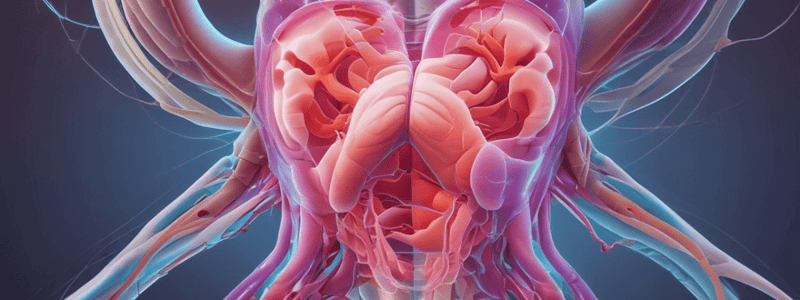Podcast
Questions and Answers
What should be done if no kidney is found during the search of the abdomen?
What should be done if no kidney is found during the search of the abdomen?
- X-ray the chest (correct)
- Administer a contrast urogram
- Perform an ultrasound of the abdomen
- Perform a CT scan of the abdomen
Which area should be searched for during the examination that involves the whole abdomen and pelvis?
Which area should be searched for during the examination that involves the whole abdomen and pelvis?
- Chest
- Kidney (correct)
- Legs
- Arms
What diagnostic procedure may be required if further investigation is needed after the initial examination?
What diagnostic procedure may be required if further investigation is needed after the initial examination?
- Echocardiogram
- Blood test
- MRI scan of the head
- Contrast urogram (correct)
In which situation would a contrast urogram not be recommended?
In which situation would a contrast urogram not be recommended?
What imaging technique specifically mentioned in the text as a potential follow-up if needed?
What imaging technique specifically mentioned in the text as a potential follow-up if needed?
Flashcards
What should be done if no kidney is found in the abdomen?
What should be done if no kidney is found in the abdomen?
If no kidney is found during an abdominal examination, an X-ray of the chest is recommended as a next step.
What area is essential to search during an examination of the abdomen and pelvis?
What area is essential to search during an examination of the abdomen and pelvis?
When examining the whole abdomen and pelvis, the kidneys are a critical area to search.
What procedure can help provide more details after the initial examination?
What procedure can help provide more details after the initial examination?
A contrast urogram is a diagnostic procedure used for further investigation when an initial examination requires more detailed information.
When would a contrast urogram not be recommended?
When would a contrast urogram not be recommended?
Signup and view all the flashcards
What imaging technique is suggested if further investigation is needed?
What imaging technique is suggested if further investigation is needed?
Signup and view all the flashcards
Study Notes
Abdominal Ultrasound Examination
- Examine the splenic and portal veins, inferior vena cava, hepatic veins, and mesentery for thickening.
- Amoebic abscesses in the spleen are rare, whereas bacterial abscesses are more common.
- Irregular, echo-free, or complex masses may be indicative of a traumatic cyst or a damaged hydatid cyst.
- A "post void" examination may be necessary to further evaluate the patient.
- The entire abdomen, including the pelvis, should be searched for any abnormalities.
- In cases where no kidney is found, an X-ray of the chest should be performed.
- A contrast urogram may be necessary to gather additional information.
Studying That Suits You
Use AI to generate personalized quizzes and flashcards to suit your learning preferences.




